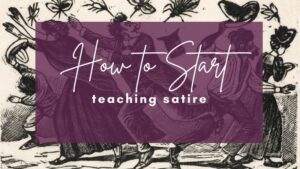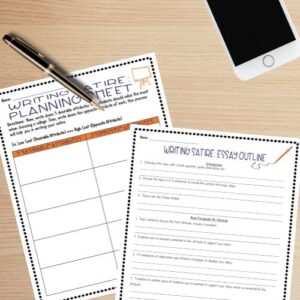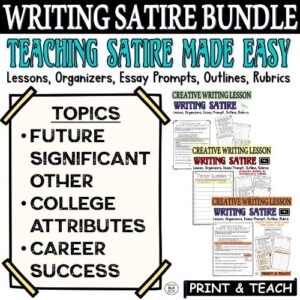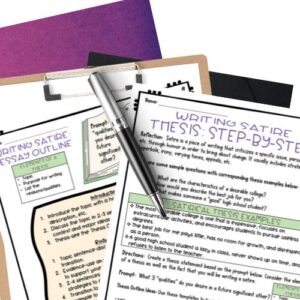Satire can be a challenge for students and teachers, but it’s a worthy challenge! I love seeing the lightbulb go on when students “get” satire. It might be as they analyze political cartoons, read an article from The Babylon Bee, or study Jonathan Swift’s “A Modest Proposal” and figure out that he wasn’t really encouraging people to eat babies. These are just a few high school satire examples; there are so many more to explore. And satire, good satire, makes us laugh and makes us think, and is so worth the effort!
If you like satire like I like satire then read on for ways to take on this challenge by incorporating more High School Satire Examples! Walk through the seven steps that highlight tips and tricks to get students reading and, better yet, writing satire to practice writing and argumentation skills. They can do this all while thinking critically and, very likely, laughing too!
Need help with Test Prep? Check out this FREE Pack of 3 Test Prep Activities to help students achieve success on standardized tests!
What Is Satire?
Satire is a genre that makes a comment on society. It can be scathing or light-hearted and usually, its goal is to bring about change. High school satire examples fall into three categories: Horatian, Juvenalian, and Menippean.
- Horatian is comical and light. Think Jane Austen commenting on the social structures in England or Mark Twain doing the same with American society.
- Juvenalian is darker and aims to speak truth to power. Jonathan Swift in “A Modest Proposal” points out the mistreatment of the Irish or “A Witch Trial at Mount Holly” supposedly by Benjamin Franklin criticizes the judicial process of the witch trials.
- Menippean is more pointed to an attitude than a person or idea. Examples here include Lewis Carroll’s Alice in Wonderland or Douglas Adams’ The Hitchhiker’s Guide to the Galaxy.
If you’re new to teaching satire with High School Satire Examples, check out this previous post as a starting guide.
Why Teach Satire?
In our current media-saturated world, getting students to think critically about what they consume is integral. This is why teaching satirical texts and encouraging students to write their own with High School Satire Examples is so valuable.
Satire pushes students to dig more deeply in order to understand a sophisticated form of argumentation. Students develop skills to read beyond the surface, use inference skills, understand rhetoric, and examine connotation and denotation. Each of these skills will make students better writers in any form. Plus, satire can be fun and that engagement is key for any lesson!
To encourage students to buy in and write with High School Satire Examples, have them write about topics they know. Then, they can focus on writing and argumentation skills. You can ask questions such as “What qualities do you want in a significant other?” to bring some forethought into your classroom or focus on career exploration by asking about the qualities they think successful people have. Then, have them flip it all around to make it part of a satirical writing task!
No matter which topic you choose, read on for seven steps to get your students to write successful satirical essays from start to finish using High School Satire Examples!
And if you want the step-by-step done-for-you option then check out the satire lesson pack bundle.
These lesson packs will help your students master satire in no time at all! From brainstorming to thesis writing, all the way through to a final essay, the lesson packs scaffold it all and provide teacher answers too! And the best part is that students will practice writing standards with a big focus on writing an argument, all while being entertained by the satirical elements they come up with themselves!
7 Steps To Teaching with High School Satire Examples
- Brainstorm: My best tip is to use realistic ideas. Get students to focus on the issues they face in life or topics that are familiar to them. Brainstorming in small groups on chart paper is a good starting point to get students to buy in from the start.
- Provide contrasting/opposite examples: Model the process of shifting from positive to negative. In the satire writing lesson about the qualities of a significant other, students draft 5 “good” qualities and their opposites (e.g. humorous/boring or caring/selfish). This gives them more options than they’ll need in the process, but that means they can pick the best of their ideas!
- Create a thesis statement: Next is establishing the foundation of the essay with a strong thesis statement. Students draw from their lists to pick the strongest 2-3 points. For students who need added support, a thesis template is a great option, so they can focus more on steps 4 and 5.
- Plan the essay: Before jumping into planning, checking out an exemplar is really helpful! Whether this is a first or a fortieth essay, walk students through the steps using a detailed outline. All of the writing satire lesson packs include exemplar paragraphs with notes to guide you and your students; plus, they have an essay template for step-by-step completion.
- Write the essay: This is where students put pen to paper or fingers to keyboard to bring their satirical essays to life. They move through the process to add their examples, provide the analysis for their claims, explore counterclaims, and conclude with a clincher. I like to encourage students to get their thoughts on paper first and then revise through the editing process.
- Consult the rubric: This is where students make sure they’re meeting expectations. Have them go through their assignment with the rubric beside them as part of their editing. Students can highlight and jot notes on their rubric and submit this with their assignment. It’s another way to ensure accountability.
- Share out time: Getting a chance to share work in class is another way to include mentor texts. You might have students share their High School Satire Examples during the process where they anonymously post their thesis statements for review. Or it could happen in a roundtable where 2-3 students share their final work.
Other ways to examine students’ high school satire examples!
Another option is to have students exchange papers and peer edit, again in consultation with the rubric. Sometimes having spent so much time with your own work it’s hard to see where it truly stands, so having a fresh set of eyes helps. Also, reading someone else’s work is yet another mentor text that can help to refine students’ work – not copying but refining! If you have the time in class, have students peer edit and then discuss their edits.
TEACHER TIP: Reviewing constructive criticism and providing sentence stems will make peer editing successful. Make it a mini-lesson like in step 2. Flip it though from negative to positive. Instead of “this idea is bad!” a student might say “a change to this section might improve the _______ (clarity, meaning, support, etc.).”
The next step would be to have students record their essays and include them in a shared class presentation (this works with written versions too). Students read a few and complete an exit ticket. I like to have students include a highlight and an area for improvement, and then finish the sentence: “After reading the other essays and thinking about my own I wish I had …” in order to reflect on their own work too.
Whether you choose to follow these 7 steps or the time-saving option with these complete print-and-go lesson packs with high school satire examples, I hope that you take on the challenge of teaching satire.
Students are consuming satire all the time, and often they might not even realize it. Other high school satire examples include memes, TikToks, and so much of today’s television and film. Satire may not be the full focus, but it comments on a particular topic with the goal of shaping or influencing the viewer, which is why we need to teach with more High School Satire Examples! Equipped with the knowledge of satire through writing their own, students can be more informed about the media they encounter every day.
Need more ideas for teaching with High School Satire Examples? Check out my store Kristin Menke-Integrated ELA Test Prep!







